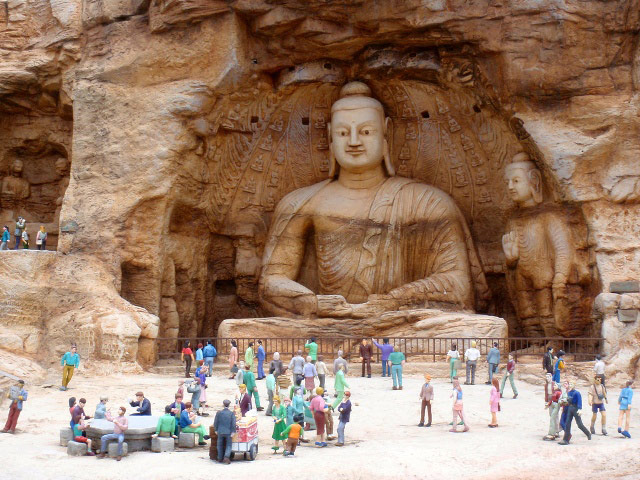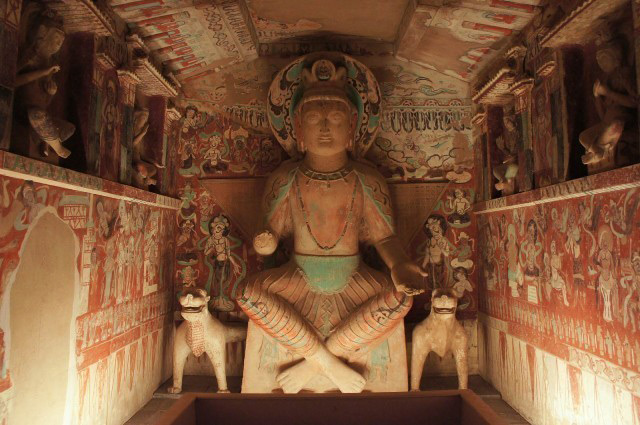Macao stone cave - China
Unesco's Scientific, Educational and Cultural Organization has recognized the Mac Cao Stone Cave as a World Cultural Heritage in 1987.
Macao Rock Cave - World Cultural Heritage in China
Mac Cao cave is a system of 492 temples about 25 km southeast of downtown Donggang in Gansu Province, China. This is also known as Thien Thien Dong or Dunhuang. Although it is called a cave, the reality is that this place is not a cave, but it is a stone carving in the form of stone carvings.

The Mac Cao Cave is the largest and most preserved treasure of Buddhist art in the world today. Mac Cao Cave is famous in the world by sculptures and frescoes, showing continuous Buddhist art throughout the thousands of years.
The Mac Cao cave began to be constructed in 366 and continued to be built during many later dynasties, the number of caves continued to increase, to the 7th century Tang Dynasty, there were more than a thousand cave, so the Mac Cao cave is also called the ' active Buddha'.

During the excavation of the cave, countless sculptors of various dynasties carved Buddha statues and painted many murals on the walls of the caves. Because Mac Cao cave is located on the 'Silk Road ' button that connects the east and the west, it is also a place of religious and cultural gathering, between the east and the west. The art forms of foreign and national art of China have been intertwined in Mac Cao cave, the diverse artistic style has made this artistic treasure become a unique landscape. world.

Over many years of history with the devastation of people and nature, Mac Cao cave has remained nearly 500 caves. Preserving about 50,000 meters of mural and more than two thousand ancient statues. The statues of Mac Cao cave look like a lot, the costumes and the expression of each statue are different, reflecting the different identities of the ages. The mural in the Mac Cao cave is also very grand, if the frescoes are joined together into a strip, it can form a 30 km long mural.
The frescoes here mostly carry Buddhist themes , such as drawings of Buddha, Bodhisattva, Thien Hoang; continuous drawings follow the story in the Buddhist scriptures; paintings of Buddhist history, etc. combined with historical stories and figures about Buddhism in India, Central Asia and China. In addition, the murals of the ages reflect the social life, costumes, jewelry, shaping ancient architecture and music, dance . of the classes and peoples of that time. Therefore, Western scholars regard the mural of Mac Cao cave as a ' museum on the wall'.

In 1900, a hidden secret contained many books that were accidentally discovered in the Mac Cao cave and the nectar was known as the "sutra-chanting" . In this three-meter-long and three-meter-wide small cave, there are more than 500 thousand precious books and historical artifacts including Kinh books, texts, embroidery, paintings, Buddha's brocade . the date of the This artifact is from the 4th to 11th centuries, their contents related to social fields such as history, politics, ethnicity, military, literary language, art and literature , religion, medicine, science and technology, etc. of China, Central Asia, South Asia and Europe, known as the " Ancient Chinese Encyclopedia ".
After the Museum of the Sutra was discovered, the ' explorer ' of the countries in the world massively arrived here. In less than 20 years, they took nearly 40,000 Kinh books and many murals and sculptures in turn, causing a great loss to Mac Cao Cave as well as China. Currently, in museums of England, France, Russia, India, Germany, Denmark, Sweden, South Korea, Finland, the US . also exhibits artifacts of Mac Cao cave, occupying two third of the total number of artifacts in the Kinh Museum.

The discovery of a treasure trove of treasures in the Mac Cao cave motivated Chinese scholars to study the texts and scriptures of the Dunhuang period. In 1910, the first book series of Dunhuang was introduced to readers, and since then, Dunhuang has been considered as 'World Study Show '. Over the past few decades, not only Chinese scholars but also scholars around the world have shown great interest in Dunhuang art and have been constantly conducting research on this period. In the study of Dong Hoang Hoc, Chinese scholars have obtained important research results.
As a precious cultural treasure of China, the Mac Cao cave has always been preserved by the Chinese government. As tourists from all over the world visit the Mac Cao cave more and more crowded, in order to protect the artifacts well, the Chinese government has built a center for displaying Don Hoang art at the foot of Tam Nguyet opposite with Mac Cao cave, restoring a part of the cave for visitors to visit.

The Chinese government also invested 200 million yuan in the construction of ' Mac Cao virtual cave' . It is known that this type of virtual cave can bring audiences to the feeling of visiting the real Mac Cao cave, and can visit the Mac Cao cave, can see all art works like ants. architecture, statues and murals in the cave. Experts and managers said that the construction of the ' Mac Cao virtual cave ', could not only avoid damaged frescoes, but also promote the recording and preservation of Dunhuang cultural wealth. making Dunhuang's artifacts and culture can extend its life and keep forever.










- Longmen Stone Cave - World Cultural Heritage in China
- Van Cuong stone cave
- Discover a beautiful cave wonder
- The ice cave never dissipates in China
- Super cave contains medium 4 Great Pyramid in China
- Detecting traces of people near Con Moong cave
- Revealing techniques for manufacturing ancient weapons from 77,000 years ago
- The location for drawing stone paintings is chosen based on music
- The largest ice cave in China does not melt in summer
- Detecting mysterious stone statues in China
- Many discoveries at the archaeological site of Con Moong cave
- Scary people into the giant cave, the hiding place of the pythons in Son La
 Suzhou classic bonsai garden - China
Suzhou classic bonsai garden - China Chau Nguyen Dynasty
Chau Nguyen Dynasty Thai Son Mountain - World Wonder
Thai Son Mountain - World Wonder Ancient villages of Shirakawa-go and Gokayama
Ancient villages of Shirakawa-go and Gokayama